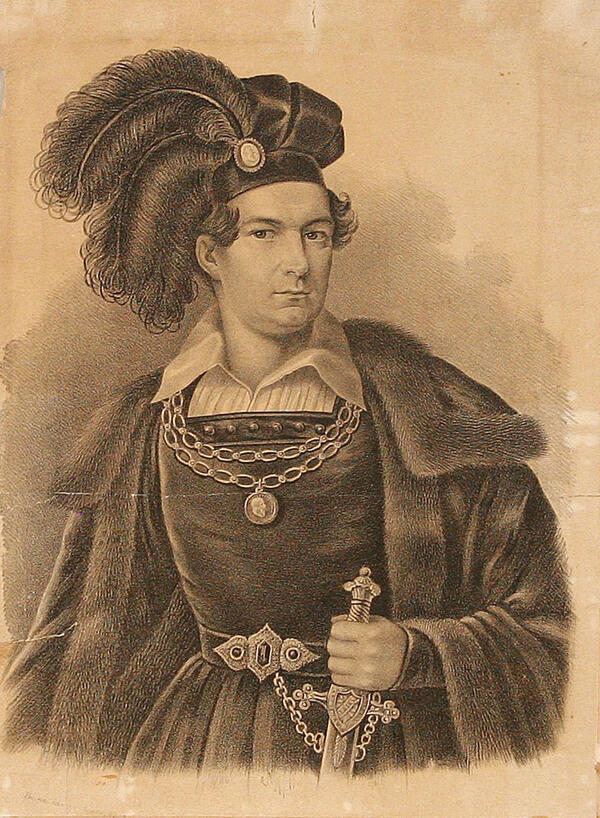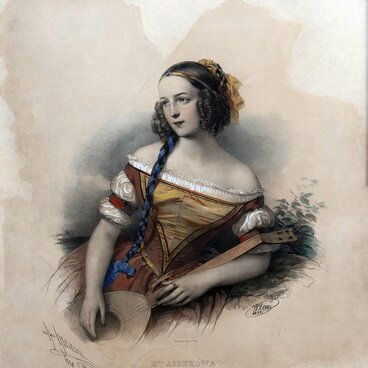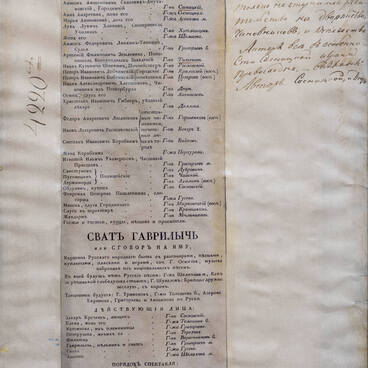The Museum of Theater and Music houses a 16th-century aristocratic costume — the authentic scene costume of Vasily Karatygin for the play “Hamlet” by William Shakespeare staged at the Alexandrinsky Theater.
In the early 19th century, the repertoire of a drama theater was mainly comprised of vaudevilles and melodramas. It was quite rare that the gems of the world literature would reach Russian theaters, and even then, they were restaged to the extent where they had little in common with the original. The tragedy “Hamlet” by Shakespeare in its original form was first introduced to the Russian public only in 1837 in translation by Nikolay Polevoy. The play was staged at two main theaters of the Russian Empire at once — the Maly Theater in Moscow starring Pavel Mochalov and the Alexandrinsky Theater in Saint Petersburg with Vasily Karatygin as the male lead.
The character of Hamlet was interpreted in two different ways, which induced heated discussions. The audience in Saint Petersburg was raving about Karatygin’s Hamlet, while the viewers in Moscow preferred Mochalov’s Hamlet who was motivated, anguished and rebellious. These two creative approaches collided, and each of them had its own circle of admirers.
The leading tragedy actor at the Alexandrinsky Theater Vasily Karatygin mastered the acting technique of that time. The literary critic Vissarion Belinsky once said that the secret of Karatygin’s success lay “not in inspiration, but the painstaking study of the role.”
Vasily Karatygin was the first to perform Chatsky in the comedy play called “Woe from Wit” by Alexander Sergeyevich Griboyedov. The premiere took place at the Alexandrinsky Theater in January 1831. Among Karatygin’s roles were the ones in Pushkin’s plays — Don Guan in “The Stone Guest” and the Baron in “The Miserly Knight.” He also performed Arbenin from the play “Masquerade” by Lermontov.
Over his career, Karatygin had many parts, including the ones in classical tragedies by Racine, Corneille, Voltaire, Shakespeare, and Schiller. He also translated and revised over 40 plays for the Russian stage.
At the beginning of his career, Karatygin was drawn to the social circle formed by progressive noblemen. The actor was acquainted with Alexander Pushkin, Alexander Griboyedov, Konstantin Ryleyev, and Wilhelm Küchelbecker. The Decembrists viewed Karatygin as a torchbearer of the revolution, since he appeared on stage as heroic and rebellious avengers and regicides. After the Decembrist Revolt had met defeat, Karatygin sided with the Conservatives, and in the 1830s he became His Majesty’s court actor and favorite.
In the early 19th century, the repertoire of a drama theater was mainly comprised of vaudevilles and melodramas. It was quite rare that the gems of the world literature would reach Russian theaters, and even then, they were restaged to the extent where they had little in common with the original. The tragedy “Hamlet” by Shakespeare in its original form was first introduced to the Russian public only in 1837 in translation by Nikolay Polevoy. The play was staged at two main theaters of the Russian Empire at once — the Maly Theater in Moscow starring Pavel Mochalov and the Alexandrinsky Theater in Saint Petersburg with Vasily Karatygin as the male lead.
The character of Hamlet was interpreted in two different ways, which induced heated discussions. The audience in Saint Petersburg was raving about Karatygin’s Hamlet, while the viewers in Moscow preferred Mochalov’s Hamlet who was motivated, anguished and rebellious. These two creative approaches collided, and each of them had its own circle of admirers.
The leading tragedy actor at the Alexandrinsky Theater Vasily Karatygin mastered the acting technique of that time. The literary critic Vissarion Belinsky once said that the secret of Karatygin’s success lay “not in inspiration, but the painstaking study of the role.”
Vasily Karatygin was the first to perform Chatsky in the comedy play called “Woe from Wit” by Alexander Sergeyevich Griboyedov. The premiere took place at the Alexandrinsky Theater in January 1831. Among Karatygin’s roles were the ones in Pushkin’s plays — Don Guan in “The Stone Guest” and the Baron in “The Miserly Knight.” He also performed Arbenin from the play “Masquerade” by Lermontov.
Over his career, Karatygin had many parts, including the ones in classical tragedies by Racine, Corneille, Voltaire, Shakespeare, and Schiller. He also translated and revised over 40 plays for the Russian stage.
At the beginning of his career, Karatygin was drawn to the social circle formed by progressive noblemen. The actor was acquainted with Alexander Pushkin, Alexander Griboyedov, Konstantin Ryleyev, and Wilhelm Küchelbecker. The Decembrists viewed Karatygin as a torchbearer of the revolution, since he appeared on stage as heroic and rebellious avengers and regicides. After the Decembrist Revolt had met defeat, Karatygin sided with the Conservatives, and in the 1830s he became His Majesty’s court actor and favorite.






